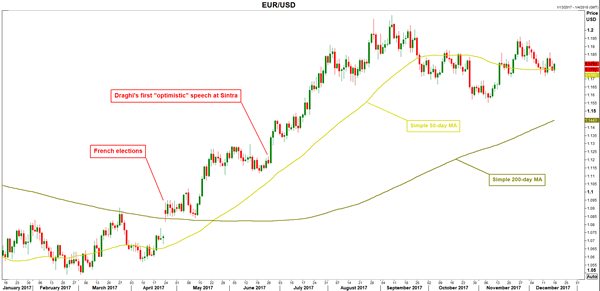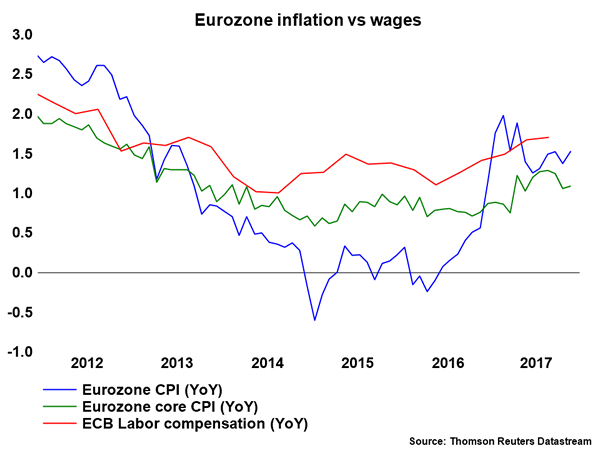Whether or not the euro will continue its bull run into 2018 is likely to depend on a variety of political and economic factors. How will the upcoming election in Italy play out, and will markets begin to price in concerns regarding the stability of the euro area ahead of the event? Moreover, will the ECB be optimistic enough to signal an end to its QE program, thereby increasing the appeal of the common currency? A reasonable scenario for the euro’s path is one where it corrects lower on political woes early in the year, only to recover its losses and perhaps trade higher by year-end, supported by Eurozone’s strengthening recovery and the ECB decreasing its stimulus dose even further.
The euro enjoyed a remarkable year in 2017, defying all skeptics to stage a spectacular bull-run that drew support from both politics and economics. The outcome of the French presidential election provided the initial spark for the rally as political risks diminished, while the bloc’s economic upturn and the subsequent optimistic rhetoric from the European Central Bank (ECB) sparked speculation for an eventual end to the QE-era. Whether or not 2018 will prove equally beneficial for the common currency is likely to depend, once again, on politics initially and on economics thereafter.

Kicking off with politics, even though the victory of Macron in the French election calmed the nerves of investors regarding more countries leaving the EU, political uncertainty could well stage a comeback in the first half of 2018, ahead of the looming general election in Italy. According to the latest opinion polls, the incumbent Democratic Party is neck and neck with the Five Star Movement, a Eurosceptic party that has previously advocated for holding a referendum on the euro. As such, heading into the election, we could see a risk premium being factored into the euro, as investors price in the possibility of a euro-exit in case of a government that includes (or is led by) the Five Star Movement.
The outcome of the election could determine the euro’s short-term prospects, with a Five Star victory likely to keep the currency under downward pressure. On the flipside, a victory by other major parties could signal a continuation of the status-quo in the Eurozone and thereby, trigger a relief rally in the euro. Such an outcome would also keep the door open for much-needed structural reforms in the EU, such as the completion of the Banking Union, the creation of a shared budget among member countries, and the introduction of some form of public risk sharing. This may be another major theme for the euro in 2018, with any signs that such reforms will be implemented likely to increase the currency’s appeal to investors, since they could be viewed as better preparing the region to handle future crises.
Turning to monetary policy, the ECB will probably take center stage in the second half of 2018, as it will be called to decide on the future of its asset purchase program. Market focus may fall on whether the Bank will opt to extend QE again, or whether it will set a roadmap towards ending the program completely. It is important to note that after the latest QE extension, key policymakers like Jens Weidmann and Benoit Coeure hinted at a clear exit from the program next year, which may be a preliminary sign of how the "heavyweights" in the ECB will vote. That said, the actual decision may depend primarily on the evolution of the bloc’s economic data and particularly, on any potential pick-up in wage growth, inflation, and economic activity.

All things considered, the euro could drift lower early next year, as market attention shifts back to politics and the possible scenario of a euro-referendum by Italy. A correction lower may be particularly visible in euro/dollar, if the expected tax package in the US was to tilt the bias in favor of the dollar in early 2018. Overall though, the currency’s broader direction will probably be decided by ECB policy. One could argue the ECB is more likely than not to signal an end to its QE program in 2018, amid an improving growth outlook for the Eurozone, financial stability concerns, and technical limitations on the eligible bonds it can buy. In such case, the common currency could well recover any potential losses it posts on political worries and perhaps manage to end the year higher, with euro/dollar potentially aiming for a test of the 1.2570 territory, marked by the highs of December 2014.














